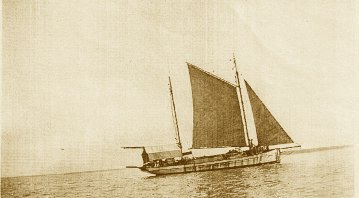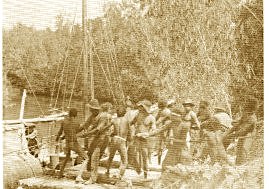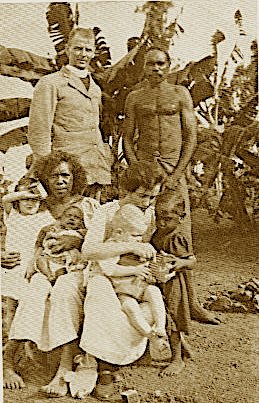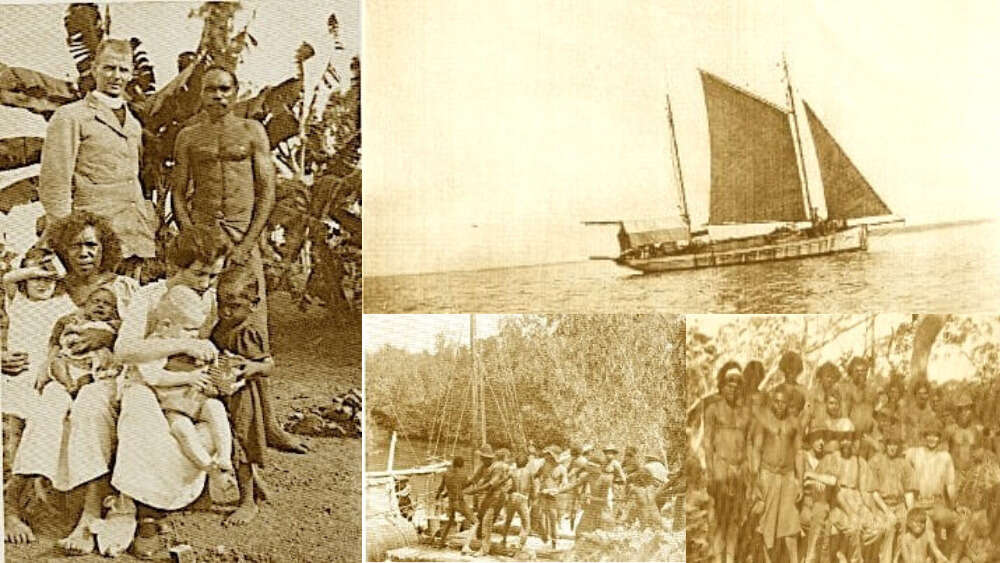As the Groote Eylandt mission celebrates its centenary on 8 October, John Harris, Bible Society historian – who spent his infancy there – recounts how it started.
The Groote Eylandt mission had its origins in an exploratory mission led by a tall, adventurous but practical missionary called Hubert Warren.
Warren, who earned his nickname as “longfella kobalili, or long lizard, from the Roper River Aboriginal people, had taken over as Superintendent of the Roper River Mission in the Western Gulf country of the Northern Territory in 1913.
The Church Missionary Society (CMS) had set up the mission at Roper River in 1909 to protect the Aboriginal people of the region, who were being massacred by white stockmen.
When that mission rapidly became a community of missionaries and Aboriginal people – Alawa people, Mara, Wandarang and other groups – with houses, gardens, stockyards, a church and a school, CMS asked Warren to look for a way to extend the mission in the Gulf.
After exploring most of the Gulf in the mission’s 5m wooden boat, Evangel – in which he had installed his own engine – Warren decided that Groote Eylandt was the best candidate for a new mission. He made three exploratory expeditions to the Gulf’s largest island in 1916 and 1917. On each trip, he took a fellow missionary and three Aboriginal men, chosen for their multilingual competence in the coastal languages, particularly Wubuy, spoken to their north around Rose River.
On each trip, he took a fellow missionary and three Aboriginal men, chosen for their multilingual competence in the coastal languages.
On the first trip in April 1916, they called in at Numbulwar. Roper River missionaries had been there before and the Nunggubuyu people were glad to see them. Helped by his Aboriginal interpreters, Warren conducted a church service at which the local people attended reverently. Afterwards, the people entreated him to establish a mission there. However, despite Warren’s encouragement, the Numbulwar Mission did not eventuate until 1952.
Warren recruited a young man, Rupert Nunggumadjbarr, to accompany them on the remainder of the trip. A Wubuy speaker, he had lived on Groote Eylandt and spoke the island’s language, Anindilyakwa. When they reached Groote, they camped beside what is now called the Angurugu River. There they met some local Aboriginal people and, as the next day was Sunday, they conducted a church service interpreted into Anindilyakwa by Nunggumadjbarr.

The Holly
The second expedition was in November and December of the same year. They sailed north to Rose River, where they met the people before continuing north, surveying the islands between the mainland and Groote. On Bickerton Island, 40 Aboriginal people met them. They slept on the island and held a service the next day before sailing on to Groote. They then spent more than two weeks circumnavigating the island and exploring the interior. Almost every day they encountered Groote Eylandters with whom they were able to establish amicable relationships – despite the Groote Eylandters’ reputation for resolute resistance to foreigners.
Rounding the southwestern point of the island, they came across the stream they named the Emerald River, a small river about 6km long and about 100m wide at the mouth. About 4km upstream, the south bank of the river presented what they judged to be a perfect site for a mission. Warren wrote in his diary:
” … miles of the best grass we have seen, freshwater creek … waterfalls with a drop of six feet. Flats easy of cultivation and irrigation by natural cause … very best timber for building … all within two miles of the sea.”
Almost every day they encountered Groote Eylandters with whom they were able to establish amicable relationships.
The third trip in 1917 was to make a small start on the layout and construction of the new mission. Despite all of them suffering dysentery, they managed to clear land near the waterfall, plant crops and construct a small log cabin of local cypress pine, so remarkably resistant to white ants. By the end of their three weeks of illness and hard labour, 36 curious Groote Eylandters were coming to observe the goings-on, some occasionally lending a hand. The missionaries learned that the place was called Yadigba. On their final day, Sunday 16 September, Warren held a church service which the local people attended with interest, after which they urged the missionaries to begin their mission as soon as possible.
It took more than three years for CMS to make plans for the new mission and for the Australian government to lease land on Groote Eylandt to CMS.
In 1920, Warren received the welcome news that the government had gazetted the whole of Groote Eylandt as an Aboriginal Reserve, leasing 500sqkm to CMS for the Emerald River Mission. CMS was then able to commit the necessary funds, appoint the mission staff and buy a lugger, the Holly. Finally, in June 1921, the Holly left for Groote Eylandt carrying the construction staff and materials.

Unloading the Holly
Now that the mission was finally happening, the local people were very willing to help where they could, unloading the heavy construction items and hauling them to the mission site. In four weeks of strenuous work, they built a weir in the river and constructed a house, jetty, goat yard and vegetable garden – as well as felling and dressing timber for taking back to Roper as building material.
The construction party left for Roper at the end of August, asking two senior Aboriginal men to take charge as caretakers of the property, Dakalarra Wurramara (b.~1870) and Damirndu Amagula (b.~1877). The party returned on 8 October to find that the two men had taken their responsibilities seriously and everything was as they had left it. These two men would associate themselves with the mission for the rest of their lives.
Missionaries Alf Dyer and Leslie Perriman, and Aboriginal workers from the Roper River Mission, moved permanently to the new mission on 8 October 1921, marking the official start of the Emerald River Mission.
These two men would associate themselves with the mission for the rest of their lives.
In a few months, they completed extensions to the mission building, built a bridge over the river with a tramway to bring in logs from the cypress forest, constructed a saw bench, mounted the boiler to run the engine for the saw and dressed 300m of timber. The local people willingly felled the timber and dragged the logs along the tramway, paid in tobacco, metal, cloth and other goods. Money was simply of no interest to them. In January 1922, Warren also moved permanently to the Emerald River Mission with his wife Ellie and son Bill.

Hubert and Ellie Warren, Daniel and children at Roper River
At Easter the next year, 31 March 1923, the mission was wiped out by a devastating cyclone, flood and tidal wave. The missionaries, the Roper River Aboriginal workers, the missionaries and 11 local Aboriginal people tried to shelter in the mission building, but it was totally destroyed – remarkably without loss of life. Initially shocked, the missionaries realised they had built the mission in a flood-prone area. Overcoming their discouragement, they chose a safer site 2km further upstream and spent the remainder of 1923 rebuilding the mission.
Initially shocked, the missionaries realised they had built the mission in a flood-prone area.
From the beginning of the Emerald River Mission, there were Groote Eylandt families who chose to live nearby and to associate with the missionaries. Within a very short time, a permanent camp developed on the river bank opposite the mission, a few kilometres upstream from the mouth of the Emerald River.
Dakalarra Wurramara and Damirndu Amagula and their immediate families never really left after they were given the task of protecting the mission as it was being constructed. Another early resident was Old Charlie Galiawa Wurramarrba (b.~1891, later Old Charlie). These early comers had a sense of ownership, quickly building firm and trusting relationships with the missionaries.[1]
Groote Eyandters, who represented the families who would become the three largest and most powerful clans on the island, had a sense of ownership of it. Far from objecting to the mission, they had been present at its genesis, had encouraged the missionaries and chosen to relocate from clan lands to the edges of the mission. The Emerald River Mission became accepted by Groote Eylandters as a permanent and meaningful institution on their land. As these first men to settle near the mission grew old, the missionaries accepted them as patriarchs of the mission.
At the Emerald River Mission, the relationship between the missionaries and the local Aboriginal people was one of mutual respect, acceptance and even, in some cases, true friendship.
On Sundays, as well as the regular morning and evening church services for the mission residents, a Christian service was conducted at the camp by the river for the local people, sometimes as many as a hundred. The whole service, including a missionary’s ‘sermon’, was translated into Anindilyakwa. No doubt some things were ‘lost in translation’, but the Christian message was nevertheless transmitted and there were those who made the conscious choice to accept it.
Dakalarra Wurramara was always regarded as the first Christian. Other early Christians were Darmirndu Amagula and Galiawa Wurramarrba (Old Charlie) and their wives. At the Emerald River Mission, the relationship between the missionaries and the local Aboriginal people was one of mutual respect, acceptance and even, in some cases, true friendship.
In 1940, the mission was destroyed yet again by an immense storm after which some buildings were never rebuilt and the other buildings deteriorated during the difficult years of World War II. CMS decided not to continue the Emerald River Mission and the mission was closed in 1943. A new mission was constructed further north on the north bank of the Angurugu river.
[1] When I was an infant, Galiawa and his wife, Didjidi Wuragwagwa, looked after me every day at their camp near the river while my mother, Margarita Harris, was busy teaching in the school. They gave me my Wurramarrba name and adopted me into the Wurramarrba clan.
Email This Story
Why not send this to a friend?


